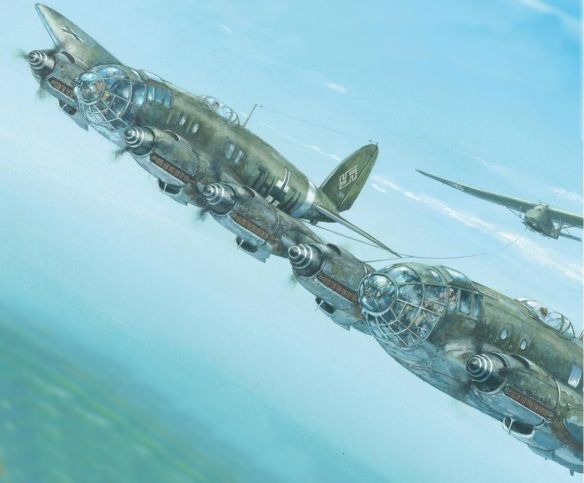Certainly, the most unusual Heinkel He.111 version, was the He 111Z (Zwilling, or twin), designed to tow the Messerschmitt Me 321 Gigant transport glider. It comprised two 111H-6 airframes joined by a new wing centre-section which mounted a fifth Jumo 211F-2 engine. Two prototypes and 10 He 111Z-1 production aircraft were built during the winter of 1941-2.
Whilst Germany had designed two heavy cargo gliders in 1940, the Me.321 and the Ju.322, the Luftwaffe had no suitable aircraft to tow them. The troika-schlepp, or triple-tow, using three Messerschmitt Bf.110C-1s, proved dangerous, and types such as the Junkers Ju.90 lacked the power required for the task. Ernst Udet conceived the idea of joining two bombers by a common central wing section, and urged the Junkers company to develop such a type.
In 1941, two prototypes of the He.111Z (Zwilling, or “twin”) were produced. Two He.111H-6 bomber fuselages with complete tail assemblies were joined by a new centre section wing having three Jumo engines (giving a total of five engines). Despite its rapid development, after testing late in 1941, and some airframe strengthening, the He.111Z proved to be an efficient glider tug, with more than enough power to tow the new giant gliders.
Take-off could be assisted by two 1,100 lb. thrust (500 kgp) JATO rockets beneath each fuselage and two 3,307 lb. thrust (1500 kgp) rockets under the centre section, one each side of the middle engine. For the large Me.321 glider, the towing cable was divided, and fixed at each central wing-root, joining between the tailplanes into a single 16 mm cable. Smaller gliders, such as the Go.242, could be towed in pairs on independent cables attached to each fuselage of the He.111Z.
A single He.111Z was able to tow three small gliders during trials, but this was not standard practice.
The He.111Z entered production early in 1942 and were placed in service that year. Only the prototypes and the first few production models used He.111H-6 airframes; the remainder were based on the He.111H-16. They were very successful, and well-liked by the crews.
The He.111Z carried a crew of seven. The pilot sat in the port fuselage, with five throttles, full instrumentation, and controls for the undercarriage members and radiator flaps for the gear and three engines on his side. The second pilot in the starboard fuselage was given dual controls but no throttles, and worked the starboard undercarriage and two sets of starboard engine radiator flaps. The second pilot also served as navigator.
A mechanic, radio operator and gunner were housed in the port fuselage, and a mechanic and gunner in the starboard.
Normal armament consisted of a 20 mm MG FF cannon in the starboard nose position and an MG 15 in the port nose. Each fuselage had a single 13 mm MG 131 in the dorsal position and a single 7.9 mm MG 15 in the rear of the ventral position and a similar weapon in a beam hatch of each fuselage. Various other armament configurations were tried, including four 13 mm MG 131s, two MG 91Z paired 7.9 mm installations, and five single MG 81J guns.
The He.111Z was not easy to control in flight, but it enjoyed a trouble-free career. Only three months had elapsed between the prototypes’ first flights and delivery into service, with only a couple of days dedicated to service evaluation. It could maintain level flight with three engines cut, provided the remaining two provided symmetrical power.
Eight of the twelve He.111Zs were destroyed in service, being shot down by fighters or destroyed as a result of bombing. The remaining four were presumably destroyed after surrender.
Heinkel He.111Z ‘Zwilling’ data
- POWER PLANT: Five Junkers Jumo 211F-2/S-2 engines. JATO rockets could be used on takeoff, one below each fuselage and one each side of the central engine.
- EMPTY EQUIPPED WEIGHT: 47,400 lb. (21500 kg)
- LOADED WEIGHT: 63,052 lb. (28600 kg)
- WING SPAN: 116 ft. 1.66 in. (35.4 m)
- LENGTH: 55 ft. 9.66 in. (16.4 m.)
- WING AREA: 1,587.06 sq. ft. (148 m²)
- DISTANCE BETWEEN FUSELAGE CENTRE LINES: 41 ft. 11.75 in. (12.8 m.)
- TOWING SPEED (2x Go.242): 155 mph (250 km/h)
- TOWING SPEED (1x Me.321): 137 mph (220 km/h)
- MAX. SPEED: 264-270 mph (425-435 km/h)
- SERVICE CEILING: In excess of 32,800 ft. (10000 m.)
- OPTIMAL CRUISING ALTITUDE: 9,030 ft. (5800 m.)
